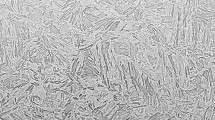Abstract
At present, hot stamping represents an innovative manufacturing process for forming of high strength steels, implying a sheet at austenite temperature being rapidly cooled down and formed into a die at the same time (quenching). This forming process is used for the manufacturing of automobile structural components with a strength of up to 1,500 MPa, thus enabling extensive cost savings and good crash performance. Better formability at elevated temperatures and lower springback are further advantages of parts formed by hot stamping. The Finite Element Analysis is an essential precondition for a good process design including all process parameters. This paper presents the finite element simulation of a hot stamping process by means of experimentally calculated material data and describes a number of procedures for the simulation of hot stamping, aiming at a notable decrease in computation time. For a faster calculation thermal and mechanical phenomena are decoupled in two simulation programs.








Similar content being viewed by others
References
Dahan Y, Chastel Y, Duroux P, Hein P, Massoni E, Wilsius J (2006) Formability investigations for the hot stamping process. International Deep Drawing Research Group IDDRG, Porto, pp 395–402
Sikora S, Lenze FJ (2006) Hot-forming-process important parameters for the production of high-strength BIW parts. International Deep Drawing Research Group IDDRG, Porto, pp 295–301
Hein P (2005) A global approach of the finite element simulation of hot stamping, advanced materials and research, vol 6–8, pp 763–770
Kolleck R, Lenze FJ (2004) Warmumformung und Kaltumformung—zwei ergänzende Verfahren für den Karosserieleichtbau. In: Siegert K (ed) Neuere Entwicklungen in der Blechumformung. Werkstoff-informationsgesellschaft, Frankfurt, pp 345–254
Turetta A, Ghiotti A, Bruschi S (2006) Testing material formability in hot stamping operations. International Deep Drawing Research Group IDDRG, Porto, pp 99–104
Mori K, Maki S, Tanaka Y (2005) Warm and hot stamping of ultra high tensile strength steel sheets using resistance heating. Ann CIRP 54(1):209–212
Kim HG, Son HS, Kang SY, Park SH (2006) Thermal–mechanical coupled simulation on the forming of hot press formed part. International Deep Drawing Research Group IDDRG, Porto, pp 349–354
Suehiro M, Kusumi K, Miyakoshi T, Maki J, Ohgami M (2003) Properties of Aluminium-coated steels for hot-forming. Nippon Steel Technical Report No. 88, pp 16–21
Garcia Aranda L, Chastel Y, Fernandez Pascual J, Dal Negro T (2002) Experiments and simulation of the hot stamping of quenchable steels, Advanced Technology of Plasticity (2002), vol 2, Proceedings of the seventh ICTP, October 28–31, Yokohama, pp 1135–1140
Tröster T, Rostek W (2004) Innovative Warmumformung, In: Siegert K (eds) Neuere Entwicklungen in der Blechumformung. Werkstoff-informationsgesellschaft, Frankfurt, pp 51–65
Griesbach B et al (2004) DE 103 14 115 A1 Verfahren zur Umformung einer Platine aus einem Vergütungsstahl und Vorrichtung zur Durchführung des Verfahrens, AUDI AG
Reinhardt A, Laurent JP, Filliettaz A (2000) Application of ultra high strength steel on the front bumper of the peugeot 607, ISATA, International symposium on automotive technology and automation, pp 95–102
Kolleck R, Pfanner S, Herbiert K, Lind C (2005) Press hardening of boron steel sheets—forming and tooling technology with high potential. International Deep Drawing Research Group IDDRG, Besancon, pp 1–10
Merklein M, Lechler J, Geiger M, Kleiner M, Karbasian H, Homberg W (2006) Untersuchung der thermo-mechanischen Fließeigenschaften presshärtbarer Stähle. Second International Conference on Accuracy in Forming Technology ICAFT 2006, in association with 13th Saxon Conference on Forming Technology SFU, Chemnitz
Geiger M, Merklein M, Hoff C (2005) Determination of the heat transfer during hot stamping. In: Steel_future for the automotive industry. Tagungsband zur internationalen Konferenz Steels in Cars and Trucks, Verlag Stahleisen GmbH, pp 179–186
Merklein M, Hoff C, Lechler J (2005) Einflussgrößen im Presshärtprozess. Car Body Colloquium CBC, Chemnitz, pp 137–153
Author information
Authors and Affiliations
Corresponding author
Additional information
The investigations presented in this paper are kindly supported by the German Research Foundation (DFG)—Research Unit FOR 552.
Rights and permissions
About this article
Cite this article
Tekkaya, A.E., Karbasian, H., Homberg, W. et al. Thermo-mechanical coupled simulation of hot stamping components for process design. Prod. Eng. Res. Devel. 1, 85–89 (2007). https://doi.org/10.1007/s11740-007-0025-9
Received:
Accepted:
Published:
Issue Date:
DOI: https://doi.org/10.1007/s11740-007-0025-9




